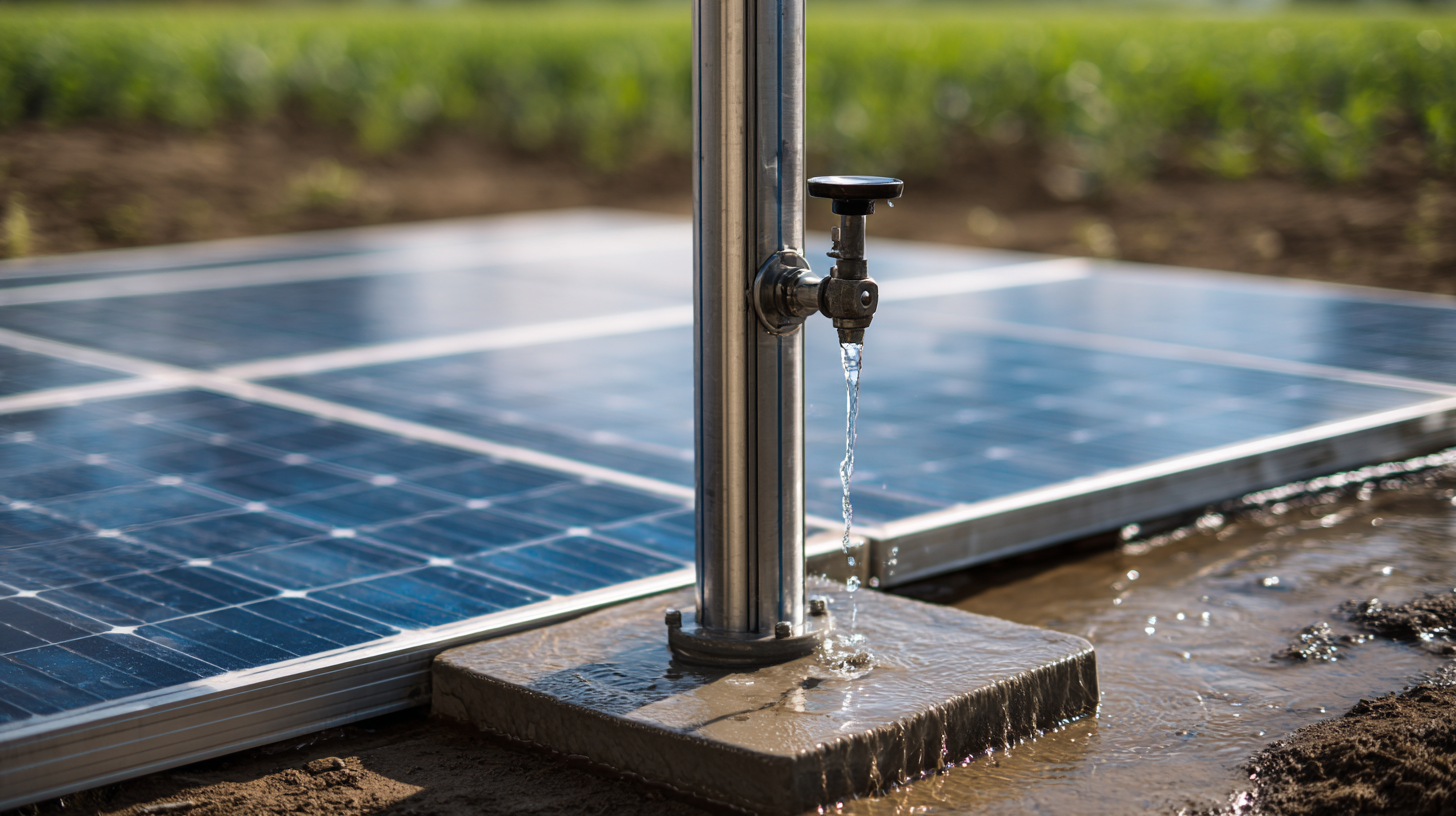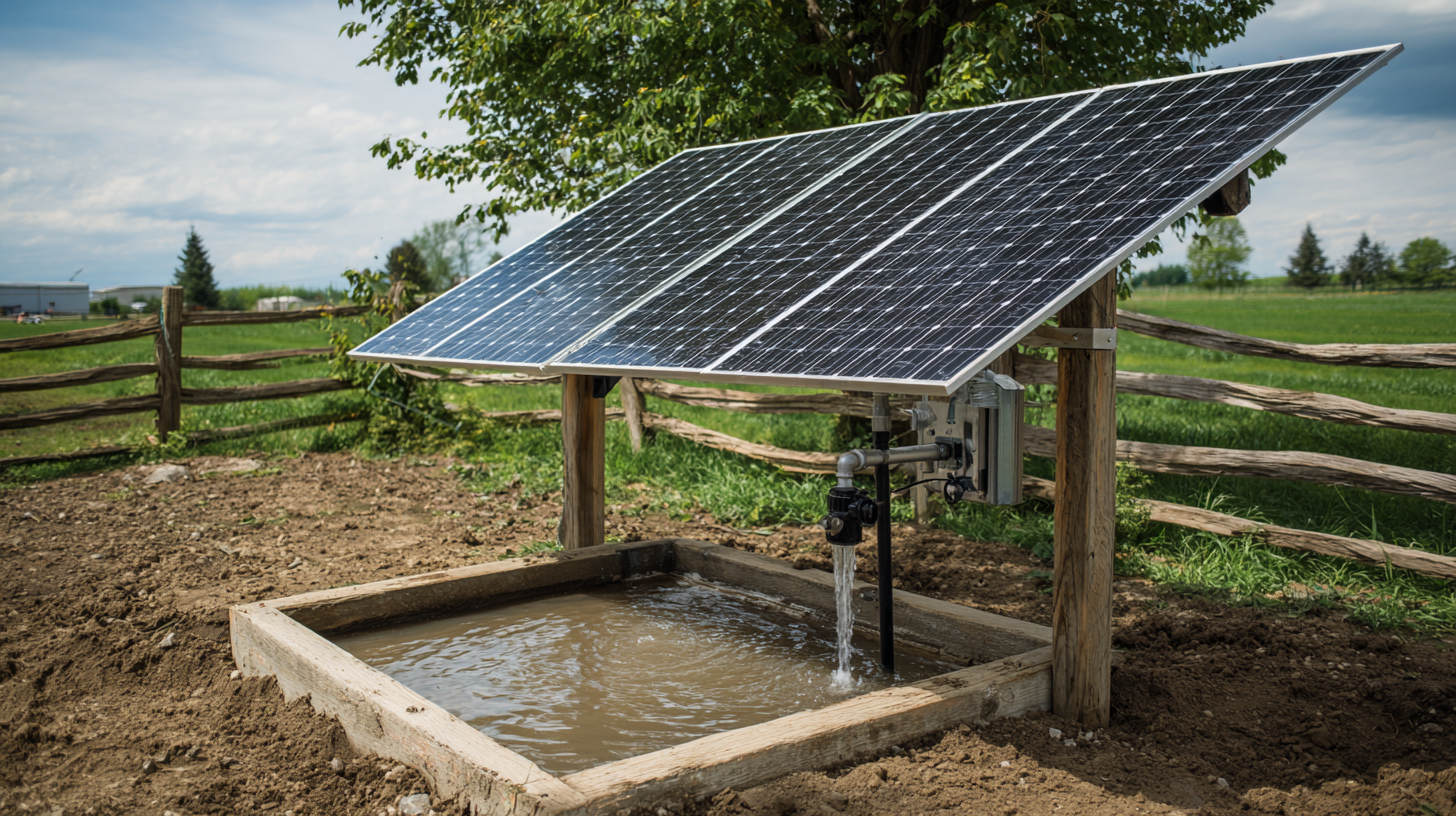Unlock the Power of Best Solar Powered Water Pumps Understanding Technical Specs and Installation Guide
 As the demand for sustainable energy solutions continues to rise,
Solar Powered Water Pumps have emerged as a pivotal technology in various sectors,
including agriculture, landscaping, and irrigation. According to a report by the International Renewable Energy Agency (IRENA),
the global market for solar water pumps is projected to grow exponentially, driven by the increasing need for
efficient and eco-friendly water supply systems. These pumps not only reduce dependence on fossil fuels
but also offer significant cost savings in the long run through lower operational and maintenance expenses.
However, understanding the technical specifications and installation processes is crucial for maximizing their benefits.
This blog will delve into the advantages of after-sales service, maintenance costs, and the future trends
in solar water pumping technology, empowering users to unlock the full potential
of their Solar Powered Water Pump systems.
As the demand for sustainable energy solutions continues to rise,
Solar Powered Water Pumps have emerged as a pivotal technology in various sectors,
including agriculture, landscaping, and irrigation. According to a report by the International Renewable Energy Agency (IRENA),
the global market for solar water pumps is projected to grow exponentially, driven by the increasing need for
efficient and eco-friendly water supply systems. These pumps not only reduce dependence on fossil fuels
but also offer significant cost savings in the long run through lower operational and maintenance expenses.
However, understanding the technical specifications and installation processes is crucial for maximizing their benefits.
This blog will delve into the advantages of after-sales service, maintenance costs, and the future trends
in solar water pumping technology, empowering users to unlock the full potential
of their Solar Powered Water Pump systems.
Understanding Solar Water Pump Technologies and Their Benefits
Solar water pumps are becoming increasingly essential in various applications, from agricultural irrigation to residential water supply. According to a report by the International Renewable Energy Agency (IRENA), the solar water pumping market is expected to grow significantly, with a projected annual growth rate of over 14% from 2021 to 2026. This surge is fueled by the increasing demand for sustainable energy solutions and the declining costs of solar technology.
Understanding the different types of solar water pump technologies is crucial for maximizing their benefits. There are primarily two types: submersible pumps and surface pumps. Submersible pumps, commonly used for deep well installations, can operate at depths of over 300 feet, providing reliable water access even in challenging terrains. Surface pumps are ideal for shallow water sources and are easier to install and maintain. Both pump types harness the sun's energy, reducing reliance on fossil fuels and offering a cost-effective solution for long-term water management.
The Environmental Protection Agency (EPA) estimates that utilizing solar-powered water pumps can reduce energy costs by up to 75% compared to traditional electric pumps, making them a smart investment for both individuals and businesses alike.
Key Technical Specifications to Consider for Solar Water Pumps
When considering solar powered water pumps, understanding the key technical specifications is crucial for optimizing performance. One of the most important factors is the pump's flow rate, typically measured in gallons per minute (GPM), which indicates how much water the pump can move. Depending on your needs—whether it's for irrigation, livestock, or residential use—you must select a pump that delivers adequate flow for your application. Pairing the right flow rate with the system's total dynamic head, which accounts for the elevation and friction losses within your piping, will ensure efficient operation.
Another critical specification is the solar panel size and wattage. The capacity of the solar panels influences how much energy is available to power the pump. Consider the pump's power requirement, which is usually measured in watts, and ensure that the solar array can meet or exceed this demand under varying sunlight conditions. Additionally, battery storage may be necessary for systems that require water during non-sunny hours, emphasizing the importance of capacity and charging times for batteries. Carefully evaluating these technical aspects will lead to a more effective and sustainable solar water pumping solution.
Solar Powered Water Pumps Technical Specifications
This chart provides an overview of essential technical specifications for solar powered water pumps, highlighting the average values across different types of pumps.
Step-by-Step Installation Process for Maximum Efficiency
 Installing a solar-powered water pump can significantly enhance your water management system while tapping into renewable energy. To kick off the installation process, start by selecting an optimal location for your pump. Look for an area that receives ample sunlight throughout the day to ensure the solar panels function at their best. As you prepare the site, consider the distance between the water source and the location of the pump; shorter distances can reduce energy loss.
Installing a solar-powered water pump can significantly enhance your water management system while tapping into renewable energy. To kick off the installation process, start by selecting an optimal location for your pump. Look for an area that receives ample sunlight throughout the day to ensure the solar panels function at their best. As you prepare the site, consider the distance between the water source and the location of the pump; shorter distances can reduce energy loss.
Once you have your location set, it’s time to assemble the components. Begin by securely mounting the solar panels at an angle to maximize sun exposure. Connect the pump to the power output of the panels, following the manufacturer’s guidelines closely. Make sure to check the electrical connections for any potential issues.
Tips: Always use high-quality cables to minimize energy loss, and consider local weather conditions when positioning your panels. After installation, monitor the system during the first few weeks to ensure everything operates efficiently. Regular maintenance checks can help prolong the life of both the pump and the solar panels, confirming that you continuously benefit from this eco-friendly solution.
Maintenance Tips for Optimal Performance of Solar Powered Pumps
Maintaining solar powered water pumps is crucial for ensuring their longevity and optimal performance. Regular maintenance tasks can prevent unexpected breakdowns and maximize efficiency. One of the key practices is to routinely check and clean the solar panels. Dust, debris, and leaves can accumulate on the surface, blocking sunlight and reducing energy generation. A simple wash with water and a soft cloth can help maintain maximum solar absorption. Additionally, it's important to inspect the wiring and connections for any signs of wear or corrosion, which can impede the electrical flow to the pump.

Another essential aspect of maintenance is monitoring the water levels and pump performance. Regularly check the flow rate and pressure to ensure that they remain consistent. If you notice a drop in performance, it may indicate blockages or issues within the pump itself. Seasonal checks for freezing or extreme weather conditions can also prevent damage to the pump components. By embracing these maintenance tips, users can keep their solar powered water pumps running smoothly, effectively harnessing renewable energy for their water needs.
Exploring Cost-Effectiveness and Return on Investment for Solar Solutions
The growing emphasis on renewable energy solutions, particularly solar power, underscores its cost-effectiveness and return on investment (ROI) in various sectors including mechanical engineering and healthcare. According to a recent BloombergNEF report, by 2050, solar and wind energy are poised to play pivotal roles in achieving global net-zero emissions. In sectors like the oil and gas industry, solar powered water pumps can provide a sustainable alternative for fluid management, leading to substantial cost savings while enhancing operational efficiency through reduced reliance on conventional energy sources.
As the global investment in clean energy seeks to accelerate, regions with abundant sunlight are particularly well-positioned for solar innovations. For example, areas in the American Southwest and parts of Africa could see a rise in applications that leverage solar technology, from agricultural irrigation systems to powering remote medical facilities. Analyzing the trends in these sectors reveals that the implementation of solar powered solutions not only aligns with sustainability goals but also offers attractive financial returns—typically, installations can achieve payback periods of under five years, making them a prudent investment in an increasingly eco-conscious market.
Unlock the Power of Best Solar Powered Water Pumps Understanding Technical Specs and Installation Guide - Exploring Cost-Effectiveness and Return on Investment for Solar Solutions
| Specification | Value | Comments |
|---|---|---|
| Power Source | Solar Energy | Eco-friendly and renewable. |
| Pump Type | Submersible | Suitable for deep water sources. |
| Flow Rate | 1000 liters/hour | Efficient for irrigation needs. |
| Solar Panel Size | 200 W | Optimum for this pump model. |
| Installation Cost | $500 | One-time cost for setup. |
| Annual Maintenance Cost | $50 | Low maintenance required. |
| Expected Lifespan | 10 years | Long-lasting performance. |
| Estimated Annual Savings | $300 | Cost-effective compared to electric pumps. |
| Return on Investment (ROI) | 1.5 years | Fast payback period. |
Contact Details
Address:
Solar Pump Solutions,
Borrisokane, Co. Tipperary, Ireland.
